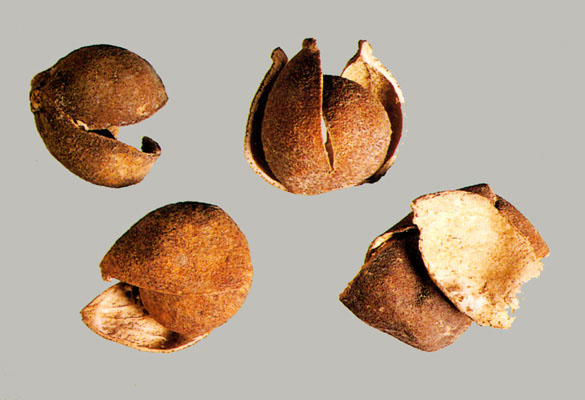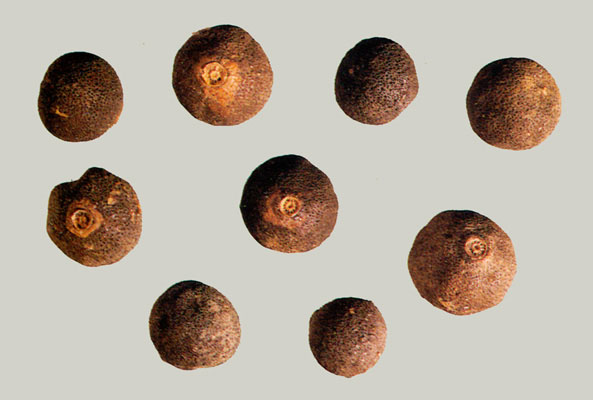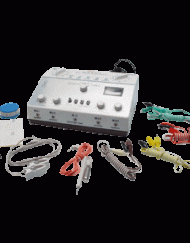Pericarpium Citri Reticulatae Viride
(Qingpi)
Green Tangerine Peel
Green Tangerine Peel is the dried pericarp of the young or immature fruits of Citrus reticulata Blanco and its cultivars (Fam. Rutaceae). The fallen young fruit is collected in May and June, dried in the sun and known commonly as “Geqingpi”. The immature friut is collected in July and August, cut longitudinally into four-valved but connected at the base, removed from the emergence completely and dried in the sun, and known commonly as “Sihuaqingpi”.
Description Sihuaqingpi Pericarp cut into four prolateelliptic lobes, long-elliptical, 4-6 cm long, 0.1-0.2 cm thick. The outer surface greyish-green or blackish-green, with numerous oil cavities; the inner surface almost white or yellowish-white, rough, with yellowish-white or yellowish-brown veins. Texture, slightly hard, easily broken, fracture showing 1-2 layers of oil cavities at the outer part. Odour, aromatic; taste, bitter and pungent.
Geqingpi Subspheroidal, 0.5-2 cm in diameter. Externally greyish-green or blackish-green, slightly rough, with numerous fine and sunken oil cavities. Remains of style, slightly projecting at the apex, and a rounded scar of fruit stalk at the base. Texture, hard, fractured pericarp yellowish-white or pale yellowish-brown, 1-2 mm thick, with 1-2 layers of oil cavities at the outer part. Pulp vescles 8-10, pale brown. Odour, delicately aromatic; taste, sour, bitter and pungent.
Identification (1) Sihuaqingpi Powder: Greyish-green or pale greyish-brown. Parenchyma of mesocarp numerous, irregular, walls slightly thickened, some beaded, Epidermal cells of pericarp polygonal or subsquare in surface view, anticlinal walls thickened, stomata oblong, 20-28 mm in diameter, subsidiary cells 5-7; covered with cuticle in lateral view, the outer radial walls slightly thickened. Prisms of calcium oxalate occurring in parenchymatous cells adjacent to the epidermis, polygonal, rhombic, or square, 8-28 mm in diameter, 24-32 mm long. Crystals of hesperidin brownish-yellow, hemispherical, subrounded or in irregular masses. Spiral and reticulated vessels small.
Geqingpi Epidermal cells of pulp vesicle narrowly prolate, walls thin, some slightly sinuous, containing prisms of calcium oxalate, similar to those of pericarp in size, also containing crystals of hesperidin.
(2) To 0.3 g of the powder add 10 ml of methanol, heat under reflux for 20 minutes, filter. To 1 ml of the filtrate, add small amount of magnesium powder and several drops of hydrochloric acid, a cherry-red colour is produced gradually.
(3) Take 5 ml of the filtrate obtained under the test for Identification (2), concentrated to about 1 ml, as the test solution and a saturated solution of hesperidin CRS in methanol as the reference solution. Carry out the method for thin layer chromatography (Appendix VI B), using silica gel G prepared with 0.5% sodium hydroxide solution as the coating substance and a mixture of ethyl acetate-methanol-water (100:17:13) as the mobile phase. Apply separately to the plate 2 ml of each of the two solutions. After developing for about 3 cm and removal of the plate, dry it in air, and then using the upper layer of methylbenzene-ethyl acetate-methanoic acid-water (20:10:1:1) as the mobile phase, after developing for about 8 cm and removal of the plate, dry it in air, spray with aluminium chloride TS. Examine under ultraviolet light (365 nm) after the methanol evaporated. The fluorescent spot in the chromatogram obtained with the test solution is observed, corresponding in position and colour to the spot in the chromatogram obtained with the reference solution.
Assay Carry out the method for high performance liquid chromatography (Appendix VI D).
Chromatographic system and system suitability Use octadecylsilane bonded silica gel as the stationary phase and a mixture of methanol-water (25:75) as the mobile phase. The wavelength of the detector is 284 nm.The number of theoretical plates of the column is not less than 1 000, calculated with the reference to the peak of hesperidin.
Preparation of reference solution Weigh accurately a quantity of hesperidin CRS, add methanol to prepare a solution containing 0.1 mg per ml and use as the reference solution.
Preparation of test solution Weigh accurately 0.2 g of the powder in a 50 ml volumetric flask, add 30 ml of methanol, ultrasonicate for 30 minutes, allow to cool, add methanol to the volume, mix well, filter, discard the initial filtrate, collect 2 ml of the successive filtrate in a 5 ml volumetric flask, add methanol to the volume, mix well and use as the test solution.
Procedure Inject accurately 10 ml of each of the reference solution and the test solution respectively into the column, determine and calculate the content.
It contains not less than 5.0% of hesperidin (C28H34O15).
Processing Pericarpium Citri Reticulatae Viride Eliminate foreign matter, wash clean, soften thoroughly, cut into thick slices or slivers, dry in the sun.
Pericarpium Citri Reticulatae Viride (processed with vine-gar) Stir-bake the slices or slivers of Pericarpium Citri Reticulatae Viride, as described under the method for stir-baking with vinegar (Appendix II D), to slightly yellow, using 15 kg of vinegar per 100 kg of Pericarpium Citri Reticulatae Viride.
Action To soothe the liver, to disintegrate stagnated qi, and to remove retained food.
Indications Distending pain in the chest and costal regions; hernia; mass formation in the breast, mastitis; abdominal pain due to retention of undigested food.
Usage and dosage 3-9 g.
Storage Preserve in a cool and dry place.













Reviews
There are no reviews yet.